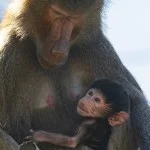
Exciting News: San Diego Zoo Welcomes First Hamadryas Baboon Baby Since 2019
The San Diego Zoo has made headlines with the joyous announcement of the birth of a baby hamadryas baboon— a significant event as it marks the first of its kind at the zoo since 2019. This heartwarming addition to the zoo, a male named Defari, which means "strong" in Ethiopian Amharic, brings forth hopes for the future of this unique species under care of dedicated wildlife professionals.
Defari was born to first-time mom Lisa Marie and father Zito, pursuant to the guidelines set by the Association of Zoos and Aquariums' (AZA) Hamadryas Baboon Species Survival Plan. This program is a systematic approach aimed at ensuring the long-term survival of threatened species through informed breeding practices and population management.
According to the AZA, the survival plans are crafted by a team of experts who assess demographic and genetic information to formulate breeding policies. These policies play a crucial role in maintaining a healthy population of hamadryas baboons, which face various threats in the wild. The meticulous management involved allows zoos to work collaboratively to ensure genetic diversity and stability for these captivating animals.

Visitors to the zoo can often catch glimpses of Lisa Marie and Defari in the Africa Rocks exhibit. The environment is lively, surrounded by the nurturing presence of other females, including Lisa Marie's mother, Daphne, eagerly awaiting their chance to bond with the young baboon. Meanwhile, Zito remains a protective figure, often seen observing with curiosity as his family interacts in their habitat.
The San Diego Zoo has ingeniously set up a Baboon Cam, allowing wildlife enthusiasts from across the globe to watch the family's dynamics unfold in real-time. Such initiatives enhance public awareness and foster an appreciation for the species, ensuring that even those unable to visit in person can engage with the extraordinary lives of these animals.
In conclusion, the birth of Defari signifies not just a joyous moment for the San Diego Zoo, but also a pivotal step in the ongoing efforts to preserve endangered species. What are your thoughts on zoo breeding programs? Do you believe they contribute sufficiently to wildlife conservation? Share your insights and let's discuss!